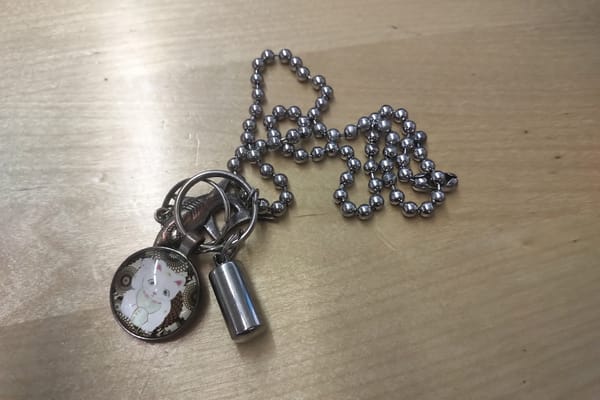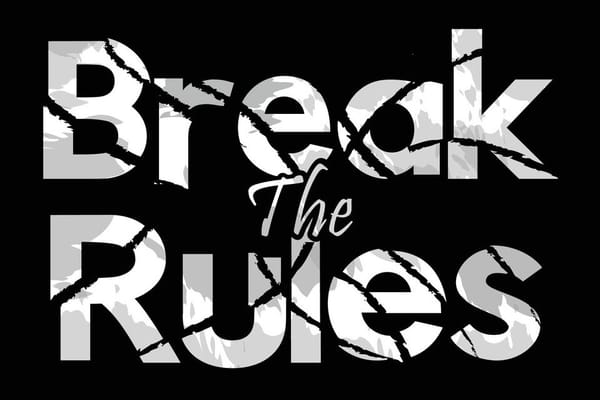You Can (Not) Perceive - Percipience Frontier: The A-Side
There's a world in front of your face that you're not seeing. Not yet.

Look up.
Colors between my skies and yours may vary. Rich blues versus hazy grays. My starless nights from urban light monopolies vs your ominous reds or radioactive greens means we both need to get out of dodge.
You look beyond that scope and there’s planets and star fields beyond where our naked eyes can reach. But before that glimmer is a world in between. A galaxy of wonder, sitting right in front of our faces, one that we cannot yet see. Yet.
The next frontier isn't the expanse of space, it's the world right in front of you.
--
Look ahead.
Human eyes have three color receptors: Reds, Greens, and Blues. This paints the color spectrum as we have it defined: the visible scale of light we perceive bottoms down at the infrareds, and ceilings out at the ultraviolets.
The Mantis Shrimp, colloquially known as the Pistol Shrimp, is the bastard of the sea. An alien-crawdad, Lobster-looking-ass menace, it's primarily known for its ability to punch so hard that it can break solid rock. That it superheats surrounding water to the point of boiling, that people say it's comparable to being shot by a handgun. The Mantis Shrimp trawls the ocean floor, searching for food and punching anything it doesn't like, which is anything that it can see.
And buddy, can it see.

Most birds have two color cones, meaning they can see on the spectrum of Yellows, Greens, and Blues.
Some of our primate cousins have four color cones. The Mantis Shrimp is blessed with not five, not six, not even ten, but eighteen different color cones.
This gifted, salty dog of the sea witnesses its world in rainbows that we don't have words for. Name me a new color. Show it to me. If you can show me a color that is yet undefined, I'll go fight a Mantis Shrimp and eat one myself, in a bid to gain its powers and see the light that we cannot.
As if that's enough to solve the discrepancy among the collective.
People's eyes have the uniformity of computer monitors. Our eyes yellow with age and exposure to the sun. It's not just you, the world actually does get less colorful the older you get. And for strike on the mound, not only are men likelier to be colorblind, usually having two cones or fewer, women are likely to be tetrachromatic, able to see in a depth of color bordering on tasting it, granting perhaps some weight to this jab:

With how much variance we've gone through in just one sense, what about the rest of them? The factors of our dominant sensory organ being such a wildcard, the lies from your eyes, and I'm sure you can imagine how much more the brain can mess with itself.
It sounds impossible, divorcing your understanding of the world from what you use to navigate it. Those robbed of sight have it bad enough, so I'm sure it sounds like I'm letting loose a flood of nonsense.
Except we're already seeing technology push us forward. Glasses exist that correct the world's color for the colorblind. There are countless videos of those in a world of a blend of twos, being moved to tears in the awe of a world of threes. It's only a matter of time before we forward engineer it to push the standard vision from three cones to four, and maybe even shades closer to the realm of the Mantis Shrimp. The pulp of fantasy made reality.
We're stepping into a world where we’re beginning to see what's truly there.
--
Look through.
Synesthesia is a phenomenon which sounds like a phantasia. Synesthetes, those who "perceive together," have brains that mix senses together. Colors have sounds. Shapes have tastes. Letters and numbers have textures. Words might have flavors. It's no disorder, it's an enviable blessing that molds the world in ways that I can only daydream. An aspect of neurodivergence which actually carries the moniker of a "superpower." Synesthetes experience the world in an abstraction of everything around them. Maybe that's not an accurate representation of everything, but it certainly sounds like a fun one.
Witness what the brain is capable of: convincing itself of it knows the throes of experience solely based on hearsay and Wikipedia.

I'm not stuck in a world of grays or cursed by a black or white. I see the blue skies and red dawns. Even if the eyes make things up faster than the Mantis Shrimp, in order to carry on a beautiful lie. I'm in my room, seeing my desk, the letters, the screen, whatever fits the operand of "OR" for whether I'm consciously deciding it's part of the background, or my unconscious judicates that for me.
If there's anything the human brain is good at, it's deluding itself. But if it's good enough to hide everything from itself, I was just talking about forward engineering, wasn't I?
It's too late for me to develop Synesthesia by some genetic freak occurrence, save the statistical lottery. Maybe meditation will bring deliverance, mayhaps technology will one day let us all taste the rainbow.
But before that advent, I can rely on the native superpower of a brain that thinks in disordered webs rather than lines. I can look back at the world through a different lens, one painted by eyes which are forged by shifted steps of perspective.
Think through, feel through. How your sights might have flavors. What the things you hear have no form. Look back through life.
I convinced myself those were coincidences. Somebody called my name and I turned and nobody was there, in the dead of nature. I bumped into something and can't see what it might have been. I explained it all away without wonder or curiosity and sacrificed the opportunity to learn and witness for the convenience of rationale.
Even if you haven't perceived it, the Mantis Shrimp might have. The Synesthete might have. Who am I to determine what's not actually there?
What's missing from the world is our ability to step out of our own perceptions.
What's truly there is not just what you want to see, but a bounty of sensory delight, lest you let it in.
I can't tell you the right way to see the world. There isn't one.
All I can tell you is that I see it through the lenses I've had scratched and tinted by time and trauma, age and experience. And by my own agency, warped with knowledge and fascination.
Friend, it is infinitely beautiful.
--
Look around.
"It's a beautiful day, and I can't see it."
You may have witnessed the viral video of a blind homeless man sitting on a busy street corner. Disheveled, hungry, and a plight of our sympathy versus our wallets, the man sits in dismay as pedestrian after pedestrian walks by. Victims of their own circumstances of labor and fiscal war.
A woman stops, looks at his sign, which reads "I'm Blind, Please Help!" She takes it, and writes over it, leaving it back to the man.
A wave of donations comes. People stop and drop wads of cash and loose coins at his feet, he can barely rake it in.
The woman returns later, the bustle of the city having lulled with the passing of the hour, and he grasps at her shoes, his feeling of recognition. Grateful beyond words and desperate to know her secrets, the question spills out, "what did you do to my sign?"
You can see the day.
It's no mere plight of sympathy, but an exchange, your grace for your perspective. Change your perceptions by not just how you physically interact, but how you think it through.
A cold glass of water after a trek through a summer street is refreshing. One after surviving the Sahara is the greatest feeling of your life.
When you're blindsided by the plight of those who lack the senses you do, not only are you hopefully overcome with the drive to help, you're driven to see the world as you can. The sky's a bit brighter. The love of your life that much more radiant.
Now push that forward. You can see the world differently when you look for it. You've been blind to the wonders of it all your life. Now your perspective is opened.
How colorful does the world look now?
--
This was written for Write of Passage, Cohort 13, Prompt 2: What's Missing?
This is the first of a three part series on perception, "Percipience Frontier" It serves as an exploration in perception, how it shapes our journey through the world, and how we might hope to step out and take control beyond what our biases force us to see and ignore.
An infinite gratitude to CansaFis Foote, and Joshua McCormick for their input during the drafting process.
To be continued on the B-Side.



